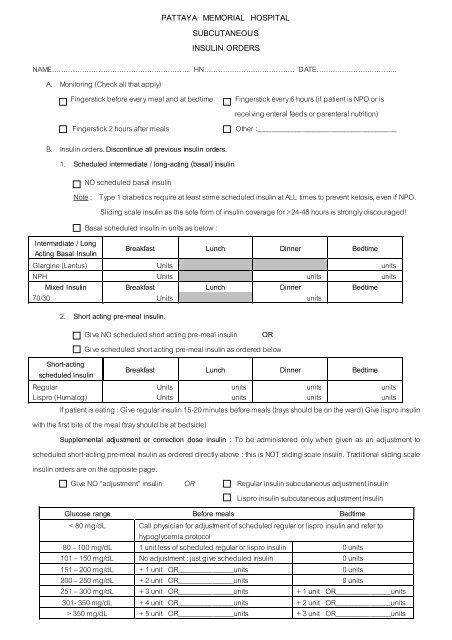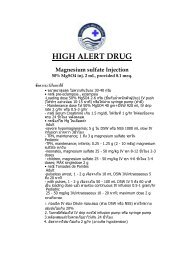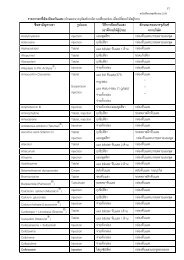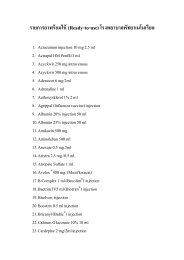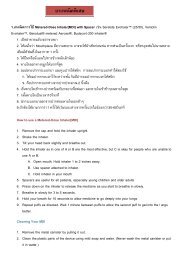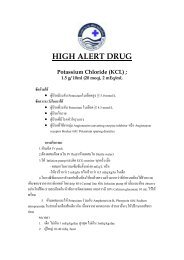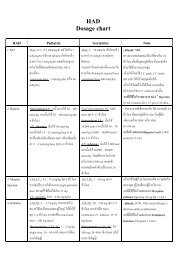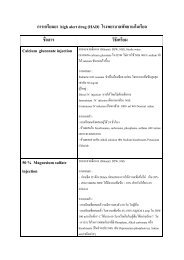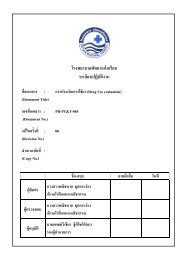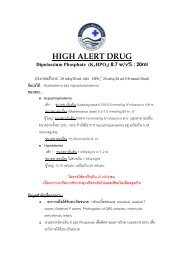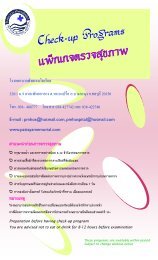pattaya memorial hospital subcutaneous insulin orders
pattaya memorial hospital subcutaneous insulin orders
pattaya memorial hospital subcutaneous insulin orders
Create successful ePaper yourself
Turn your PDF publications into a flip-book with our unique Google optimized e-Paper software.
PATTAYA MEMORIAL HOSPITAL<br />
SUBCUTANEOUS<br />
INSULIN ORDERS<br />
NAME………………………………………….……….. HN………………………………… DATE……………………………..<br />
A. Monitoring (Check all that apply)<br />
Fingerstick before every meal and at bedtime Fingerstick every 6 hours (if patient is NPO or is<br />
receiving enteral feeds or parenteral nutrition)<br />
Fingerstick 2 hours after meals<br />
Other :________________________________________<br />
B. Insulin <strong>orders</strong>. Discontinue all previous <strong>insulin</strong> <strong>orders</strong>.<br />
1. Scheduled intermediate / long-acting (basal) <strong>insulin</strong><br />
NO scheduled basal <strong>insulin</strong><br />
Note : Type 1 diabetics require at least some scheduled <strong>insulin</strong> at ALL times to prevent ketosis, even if NPO.<br />
Sliding scale <strong>insulin</strong> as the sole form of <strong>insulin</strong> coverage for >24-48 hours is strongly discouraged!<br />
Basal scheduled <strong>insulin</strong> in units as below :<br />
Intermadiate / Long<br />
Acting Basal Insulin<br />
Breakfast Lunch Dinner Bedtime<br />
Glargine (Lantus) Units units<br />
NPH Units units units<br />
Mixed Insulin Breakfast Lunch Dinner Bedtime<br />
70/30 Units units<br />
2. Short acting pre-meal <strong>insulin</strong>.<br />
Give NO scheduled short acting pre-meal <strong>insulin</strong> OR<br />
Give scheduled short acting pre-meal <strong>insulin</strong> as ordered below<br />
Short-acting<br />
scheduled Insulin<br />
Breakfast Lunch Dinner Bedtime<br />
Regular<br />
Lispro (Humalog)<br />
Units<br />
Units<br />
units<br />
units<br />
units<br />
units<br />
units<br />
units<br />
If patient is eating : Give regular <strong>insulin</strong> 15-20 minutes before meals (trays should be on the ward) Give lispro <strong>insulin</strong><br />
with the first bite of the meal (tray should be at bedside)<br />
Supplemental adjustment or correction dose <strong>insulin</strong> : To be administered only when given as an adjustment to<br />
scheduled short-acting pre-meal <strong>insulin</strong> as ordered directly above : this is NOT sliding scale <strong>insulin</strong>. Traditional sliding scale<br />
<strong>insulin</strong> <strong>orders</strong> are on the opposite page.<br />
Give NO “adjustment” <strong>insulin</strong> OR Regular <strong>insulin</strong> <strong>subcutaneous</strong> adjustment <strong>insulin</strong><br />
Lispro <strong>insulin</strong> <strong>subcutaneous</strong> adjustment <strong>insulin</strong><br />
Glucose range Before meals Bedtime<br />
< 80 mg/dL Call physician for adjustment of scheduled regular or lispro <strong>insulin</strong> and refer to<br />
hypoglycemia protocol<br />
80 – 100 mg/dL<br />
101 – 150 mg/dL<br />
1 unit less of scheduled regular or lispro <strong>insulin</strong><br />
No adjustment : just give scheduled <strong>insulin</strong><br />
0 units<br />
0 units<br />
151 – 200 mg/dL + 1 unit OR________________units 0 units<br />
200 – 250 mg/dL + 2 unit OR________________units 0 units<br />
251 – 300 mg/dL + 3 unit OR________________units + 1 unit OR________________units<br />
301- 350 mg/dL + 4 unit OR________________units + 2 unit OR________________units<br />
> 350 mg/dL + 5 unit OR________________units + 3 unit OR________________units
3. Sliding Scale Insulin Note : Prolonged use of sliding scale <strong>insulin</strong> regimens as the sole form of <strong>insulin</strong> coverage<br />
is strongly discouraged! Rapid transition to a regimen that includes basal <strong>insulin</strong> is usually appropriate. Do not<br />
use this scale to supplement scheduled short-acting pre-meal <strong>insulin</strong>.<br />
Give NO sliding scale <strong>insulin</strong> OR Regular <strong>insulin</strong> <strong>subcutaneous</strong> (15-20 minutes before meals).<br />
Lispro <strong>insulin</strong> <strong>subcutaneous</strong> (with first bite of meal)<br />
If patient eating<br />
If not eating<br />
Glucose range Before meals Bedtime Every 6 hours<br />
< 80 mg/dL 0 units 0 units 0 units<br />
80 – 100 mg/dL 1 unit or_______units 0 units 1 unit or_______units<br />
101 – 150 mg /dL 2 units or_______units 0 units 2 units or_______units<br />
151 – 200 mg/dL 4 units or_______units 0 units 4 units or_______units<br />
201 – 250 mg/dL 6 units or_______units 0 units 6 units or_______units<br />
251 – 300 mg/dL 8 units or_______units 3 units or_______units 8 units or_______units<br />
301 – 350 mg/dL 10 units or_______units 4 units or_______units 10 units or_______units<br />
> 350 mg/dL 12 units or_______units 5 units or_______units 12 units or_______units<br />
C. Notify physician for :<br />
1. Glucose < 60 mg/dL or < 80 mg/dL accompanied by symptoms, and implement hypoglycemia decision<br />
tree protocol.<br />
2. Glucose > 400 mg/dL.<br />
3. Adjustment if half or more of glucose levels in a 48-hour period are > 200 mg/dL.<br />
D. Hypoglycemia Decision Tree Protocol<br />
I. Assessment<br />
● Symptoms of hypoglycemia are reported or observed ; If on <strong>insulin</strong> drip, turn off <strong>insulin</strong> drip.<br />
● Blood glucose test performed. Results reported to RN.<br />
II. Intervention<br />
A. Blood glucose < 40 mg/dL with or without symptoms<br />
● Unconscious without IV –<br />
Give 1 mg glucagon <strong>subcutaneous</strong>ly once and start IV of normal saline with saline lock. If no<br />
response in 10 minutes, give 20 mL D50W slow IV push once.<br />
● Unconscious or NPO with IV –<br />
Give 20 mL D50W slow IV push once. Check blood glucose in 15 minutes. Follow protocol based<br />
on blood glucose reading.<br />
● Conscious –<br />
Repeat blood glucose test. Give 8 ounces of juice.<br />
B. Blood glucose 40 – 60 mg/dL with or without symptoms<br />
Give 4 ounces of juice. Check blood glucose in 15 minutes.<br />
If blood glucose < 60 mg/dL or symptomatic, follow decision tree for unconscious patient.<br />
If blood glucose < 60 mg/dL and no symptoms, follow with snack<br />
C. Blood glucose > 60 mg/dL without symptoms<br />
DO NOT TREAT. There is no hypoglycemia.<br />
D. Blood glucose 61 – 80 mg/dL with symptoms<br />
Initial treatment : Give 4 ounces of juice. Check blood glucose in 15 minutes.<br />
If blood glucose < 60 mg/dL or symptomatic, follow decision tree for unconscious patient.<br />
If blood glucose < 60 mg/dL and no symptoms, follow with snack of peanut butter or give next<br />
meal tray.<br />
Recheck glucose 1 hour after snack.<br />
III. Following episode<br />
Assess for cause of hypoglycemia (e.g., missed or delayed meal, extra <strong>insulin</strong>).<br />
Document episode and instruct patient / family re : avoiding hypoglycemia.<br />
Notify physician. Complete adverse drug reaction form, if applicable.<br />
________________________________________<br />
________________________________________<br />
Physician Signature Date & Time Nurse Signature Date & Time
Guidelines for Insulin Use and Care of the Hospitalized Patient with Hyperglycemia<br />
Frequency Of Glucose Testing And Glycemic Targets<br />
1. Target blood glucose is 100 – 150 mg/dL. Poor glycemic control = poor outcomes.<br />
2. Point of care tests at least before each meal and at bedtime unless NPO / tube feeds, then q6h.<br />
General Insulin Dosing Recommendations<br />
1. Type 1 DM – <strong>insulin</strong> is necessary at all times (even when NPO).<br />
● Must continue basal / scheduled <strong>insulin</strong> and add mealtime <strong>insulin</strong> for caloric needs.<br />
2. Individualize Insulin Dose<br />
● Use outpatient dose for baseline and increase (infection, steroids) or decrease (fewer calories ingested than<br />
when at home) as needed.<br />
● Resume outpatient regimen If blood glucose is well controlled unless patient is NPO.<br />
3. Never previously on <strong>insulin</strong> – estimate dose based on patient’s body weight.<br />
● Type 1 DM – 0.6 units / kg dose to start; ½ dose as basal <strong>insulin</strong> and ½ dose as mealtime <strong>insulin</strong>.<br />
Adjust to maintain glucose between 100 – 150 mg/dL.<br />
For example a 70 kg man eating the average <strong>hospital</strong> meal will require approximately 42 (0.6 units/kg x 70 kg) units of insuli n per day.<br />
One half or 21 units as a basal <strong>insulin</strong> (e.g. Glargine 21 units qhs or Ultralente 10 units bid), and the other half as mealtime <strong>insulin</strong><br />
(Lispro 7 units with each meal). This should be adjusted accordingly, to maintain glucose levels between 100-150 mg/dL.<br />
● Type 2 DM – usually require higher doses – more than 1 unit / kg per day.<br />
4. Important!! Evaluate <strong>insulin</strong> dose daily. Adjust if needed to prevent hyper or hypoglycemia.<br />
5. Type 2 DM – some oral agents may need to change.<br />
● Sulfonvlureas; risk for hypoglycemia if NPO; Metformin; lactic acidosis risk with renal insufficiency.<br />
Glitazones; risk for fluid overload and exacerbation of CHF.<br />
Supplemental adjustment or correction dose <strong>insulin</strong><br />
1. This is not the traditional sliding scale <strong>insulin</strong>. It is an adjustment dose used to supplement scheduled regular or lispro<br />
<strong>insulin</strong>.<br />
2. You can not order sliding scale <strong>insulin</strong> on top of scheduled regular or lispro <strong>insulin</strong>, as it would likely lead to<br />
hypoglycemia. Use supplemental adjustment dose <strong>insulin</strong> for this to fine tune control.<br />
Sliding Scale Insulin<br />
1. Do not use as sole diabetic treatment unless NPO or problem prediction basal amount.<br />
2. Adjust sliding scales and basal <strong>insulin</strong> dosing every 1 – 2 days.<br />
3. Transition to using scheduled long acting (basal) <strong>insulin</strong> and scheduled pre-meal <strong>insulin</strong> ASAP.<br />
Peri-Operative and Peri-Procedure Orders<br />
1. Do not use sliding scale as sole diabetic treatment (generally).<br />
2. Type 2 diabetics well controlled on oral agents: simply keep NPO.<br />
3. Day of procedure : Hold sulfonylureas, metformin and alpha-glucosidase inhibitors, resume when patient eats.<br />
Thiazolidinediones can be continued if fluid retention is not a concern.<br />
4. IV fluids to contain dextrose, test glucose q 1 – 2 hr during case.<br />
5. IV <strong>insulin</strong> infusions are ideal in patients who are NPO for more than 10 – 12 hours.<br />
6. See Insulin Infusion Order set for details / instructions on transitioning from IV to <strong>subcutaneous</strong> <strong>insulin</strong>.<br />
7. For <strong>subcutaneous</strong> regimens:<br />
1. AM of procedure : Give ½ of long / intermediate-acting <strong>insulin</strong> (such as NPH or Lantus) or ( ½ to 2/3 of<br />
the usual dose in Type 1 patients).<br />
2. Do not give rapid / short-acting <strong>insulin</strong> unless the glucose is > 200 mg/dL, and then give small doses<br />
(1-4 units to a glucose of around 150 mg/dL).<br />
Call Tammy Finger (diabetic educator) and Joe Yu MD or Internal Medicine <strong>hospital</strong>ist for consultation if you have questions<br />
or difficulty achieving good control without hypoglycemia.


